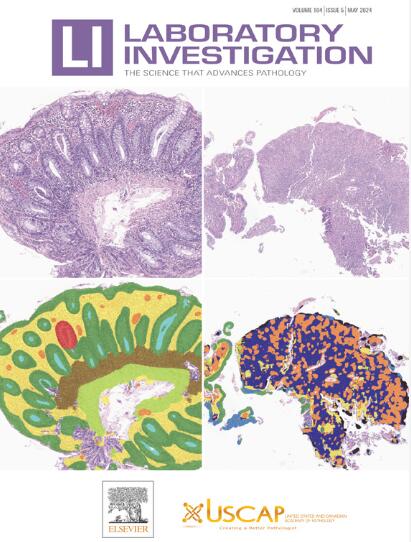三级淋巴结构中的淋巴细胞功能可预测肝细胞癌的预后
IF 5.1
2区 医学
Q1 MEDICINE, RESEARCH & EXPERIMENTAL
引用次数: 0
摘要
越来越多的研究揭示了三级淋巴结构(TLS)与肝细胞癌(HCC)预后之间的相关性。然而,细胞组成的异质性与 HCC 总生存期(OS)之间的关系仍未得到探讨。在此,我们使用多重免疫荧光技术评估了南通大学附属肿瘤医院收治的150例HCC患者的癌组织,以确定TLS的存在和特征,并研究TLS内免疫活性、TLS成熟度和瘤内免疫细胞浸润之间的关系。通过单变量和多变量分析确定了影响预后的因素。此外,还测定了细胞毒性T淋巴细胞抗原-4(CTLA-4)、程序性死亡1(PD-1)、程序性死亡配体1(PD-L1)和淋巴细胞活化基因-3(LAG3)的水平及其与TLS特征的关系。在 150 例 HCC 中,有 71 例(47.3%)检测到 TLS,且与较高的瘤内淋巴细胞浸润水平有关。此外,TLS 内淋巴细胞增殖与瘤内淋巴细胞增殖相关,TLS 的存在和成熟 TLS 的高比例与较好的预后有显著相关性(分别为 p=0.013 和 p=0.03)。在TLS阳性肿瘤中,表达活化诱导胞苷脱氨酶(AID)的B细胞比例高和表达CD45RO的CD8+T细胞比例高与OS改善显著相关(p=0.01),p+CD20+B细胞与较差的OS显著相关(与TLS阳性肿瘤相比,在TLS阴性肿瘤的基质区观察到p+细胞(p=0.01)。这些发现揭示了TLS的存在与HCC患者OS改善之间的相关性。然而,TLS 在成熟状态、T 细胞和 B 细胞增殖以及 B 细胞和 T 细胞功能相关标记物的表达方面表现出明显的差异。值得注意的是,这些特征还具有预后意义,表明某些 TLS 可能会通过抑制免疫细胞来阻碍肿瘤免疫,而其他 TLS 则可能会促进抗原驱动的免疫反应,这可能受到 TLS 内淋巴细胞的组成和功能状态的影响。本文章由计算机程序翻译,如有差异,请以英文原文为准。
Lymphocyte Function in Tertiary Lymphoid Structures Predicts Hepatocellular Carcinoma Outcome
An increasing number of studies have revealed a correlation between tertiary lymphoid structures (TLSs) and the outcome of hepatocellular carcinoma (HCC). Nevertheless, the associations between the heterogeneity of cellular composition and the overall survival (OS) in HCC remain unexplored. Here, we evaluated the cancer tissues from 150 HCC individuals using multiplex immunofluorescence to determine the presence and characteristics of TLS and to investigate the relationship between intra-TLS immunologic activity, TLS maturation, and intratumoral immune cell infiltration. Prognostic factors influencing the outcome were identified through both univariate and multivariate analyses. Additionally, the levels of cytotoxic T-lymphocyte antigen-4 (CTLA-4), programmed death 1, programmed death-ligand 1, and lymphocyte activation gene-3 were determined, as well as their relationship with TLS features were determined. TLS was detected in 71 (47.3%) of the 150 HCC cases and was related to higher intratumoral infiltration levels of lymphocytes. Additionally, intra-TLS lymphocyte proliferation correlated with that of intratumoral lymphocytes, and the presence of TLS and a high proportion of mature TLS demonstrated a significant correlation with better prognosis (P = .013 and P = .03, respectively). Among TLS-positive tumors, a high proportion of B cells expressing activation-induced cytidine deaminase and a high proportion of CD8+ T cells expressing CD45RO were significantly related to improved OS (P = .01 and P < .001, respectively). Comparatively, a high proportion of CD21+CD20+ B cells demonstrated a significant correlation with poorer OS (P < .001). A markedly reduced number of CTLA-4+ cells in the stromal regions in TLS-negative tumors was observed compared with TLS-positive tumors (P = .01). These findings reveal a correlation between TLS presence and improved OS in HCC patients. However, TLS exhibited significant variation in maturation state, T- and B-cell proliferation, and expression of markers related to B- and T-cell function. Notably, these characteristics were also found to possess prognostic significance, indicating that certain TLS might hinder tumor immunity by inhibiting immune cells, whereas others may foster antigen-driven immune responses, likely influenced by the composition and functional status of intra-TLS lymphocytes.
求助全文
通过发布文献求助,成功后即可免费获取论文全文。
去求助
来源期刊

Laboratory Investigation
医学-病理学
CiteScore
8.30
自引率
0.00%
发文量
125
审稿时长
2 months
期刊介绍:
Laboratory Investigation is an international journal owned by the United States and Canadian Academy of Pathology. Laboratory Investigation offers prompt publication of high-quality original research in all biomedical disciplines relating to the understanding of human disease and the application of new methods to the diagnosis of disease. Both human and experimental studies are welcome.
 求助内容:
求助内容: 应助结果提醒方式:
应助结果提醒方式:


